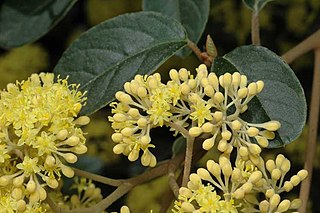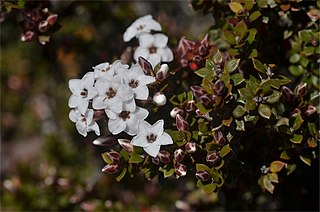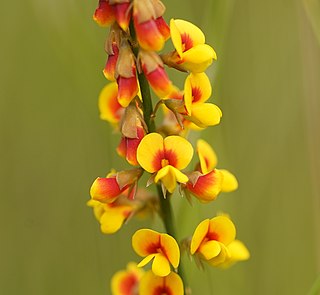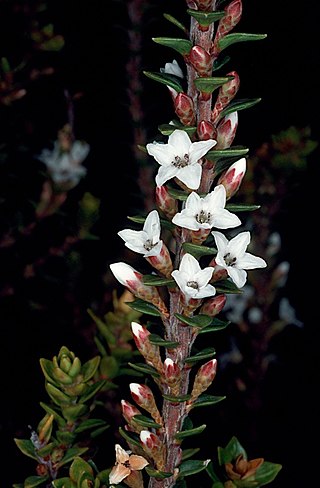
Olearia argophylla, commonly known as musk daisy-bush, native musk or silver shrub, is a species of flowering plant in the family Asteraceae and is endemic to south-eastern Australia. It is a shrub or tree with silvery branchlets, egg-shaped to elliptic leaves, and white and yellow, daisy-like inflorescences.

Pomaderris elliptica, commonly known as yellow dogwood or smooth pomaderris, is a species of flowering plant in the family Rhamnaceae and is endemic to south-eastern Australia. It is a shrub with densely hairy branchlets, egg-shaped or elliptic leaves, and pale yellow flowerss.

Olearia myrsinoides, commonly known as silky daisy-bush or blush daisy bush, is a species of flowering plant in the family Asteraceae and is endemic to south-eastern Australia. It is a spreading shrub with hairy branchlets, egg-shaped to elliptic leaves with toothed edges, and white and yellow or mauve, daisy-like inflorescences.

Epacris serpyllifoliais a species of flowering plant in the heath family Ericaceae and is endemic to Tasmania. It is a small low-lying or weakly erect shrub with heart-shaped to broadly egg-shaped leaves and tube-shaped white flowers crowded in upper leaf axils.

Hibbertia acicularis, commonly known as prickly guinea-flower, is a species of flowering plant in the family Dilleniaceae and is endemic to eastern Australia. It is an erect or prostrate shrub with linear to lance-shaped leaves and yellow flowers arranged singly in leaf axils with the six to eight stamens joined at the base, in a single cluster.

Pultenaea dentata, commonly known as clustered bush-pea, is a species of flowering plant in the family Fabaceae and is endemic to south-eastern Australia. It is an erect to low-lying or prostrate, open shrub with elliptic to narrow egg-shaped leaves and dense clusters of yellow, red and purple flowers.
Epacris apsleyensis is a species of flowering plant in the heath family Ericaceae and is endemic to a small area of Tasmania. It is an erect shrub with hairy branchlets, lance-shaped to elliptic leaves and tube-shaped flowers with white petals.

Epacris barbata, commonly known as bearded heath, is a species of flowering plant in the heath family Ericaceae and is endemic to a restricted area of Tasmania. It is an erect shrub with lance-shaped leaves and white, tube-shaped flowers with hairy sepals.
Epacris grandis, commonly known as grand heath or tall heath, is a species of flowering plant in the heath family Ericaceae and is endemic to a small area of Tasmania. It is a robust, erect shrub with smooth stems, lance-shaped leaves and tube-shaped flowers with white petals.

Epacris graniticola, commonly known as granite heath, is a species of flowering plant in the heath family Ericaceae and is endemic to Tasmania. It is an erect shrub with egg-shaped leaves and tube-shaped white flowers mostly clustered near the ends of branches.

Leucopogon collinus, commonly known as fringed beard-heath, is a species of flowering plant in the heath family Ericaceae and is endemic to south-eastern Australia. It is a slender, erect or spreading shrub with narrowly lance-shaped leaves, and white, tube-shaped, bearded flowers.
Epacris limbata, commonly known as bordered heath or border heath, is a species of flowering plant in the heath family Ericaceae and is endemic to a restricted area of Tasmania. It is an erect shrub with narrowly heart-shaped or broadly egg-shaped, stem-clasping, sharply-pointed leaves and tube-shaped white flowers clustered along the ends of branches.
Epacris moscaliana, commonly known as seepage heath, is a species of flowering plant in the heath family Ericaceae and is endemic to Tasmania. It is a bushy shrub with wand-like branches, narrowly lance-shaped to egg-shaped or round leaves, and bell-shaped white flowers in clusters at the ends of the branches.

Sphaerolobium minus, commonly known as globe-pea, is a species of flowering plant in the family Fabaceae and is endemic to south-eastern Australia. It is an erect, rush-like, mostly leafless shrub with yellow and reddish flowers arranged in small groups along the stems.

Epacris heteronema is a species of flowering plant in the heath family Ericaceae and is endemic to Tasmania. It is an erect shrub with many branches, that typically grows to a height of 0.6–6 m. Its leaves are egg-shaped with an often heart-shaped base and a sharply-pointed tip. The flowers are arranged singly in a few leaf axils near the ends of the branches and are white and tube-shaped, with lobes about the same length as the petal tube.

Epacris mucronulata is a species of flowering plant in the heath family Ericaceae and is endemic to Tasmania. It is an erect shrub with softly-hairy young branches, lance-shaped leaves, and cylindrical white flowers in small groups at the ends of the branches.

Epacris myrtifolia is a species of flowering plant in the heath family Ericaceae and is endemic to Tasmania. It is an erect shrub that typically grows to a height of 15–50 cm (5.9–19.7 in). Its leaves are thick, crowded, egg-shaped with a small, blunt point on the tip, and 4.2–8.5 mm (0.17–0.33 in) long. The flowers are arranged singly in a few upper leaf axils with many leathery bracts at the base. The sepals are leathery, about 4.2 mm (0.17 in) long, the petal tube slightly shorter than the sepals with lobes about the same length, the anthers protruding slightly from the petal tube.

Epacris paludosa, commonly known as swamp heath, is a species of flowering plant from the heath family, Ericaceae, and is endemic to eastern Australia. It is an erect, bushy shrub with lance-shaped, elliptic or egg-shaped leaves and tube-shaped white or cream-coloured flowers in crowded, leafy heads at the ends of branches.

Epacris tasmanica is a species of flowering plant in the heath family Ericaceae and is endemic to Tasmania. It is an erect shrub with lance-shaped leaves and tube-shaped white flowers crowded in upper leaf axils.

Olearia teretifolia is a species of flowering plant in the family Asteraceae and is endemic to south-eastern Australia. It is a bushy shrub with lance-shaped, egg-shaped or elliptic leaves arranged in opposite pairs, and white and yellow, daisy-like inflorescences.

















